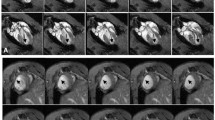Abstract
Purpose
The purpose of this study was to detect and follow transplanted superparamagnetic iron oxide (SPIO)-labeled endothelial progenitor cells (EPCs) by magnetic resonance imaging (MRI).
Procedures
Infarcted rats were randomized to injections of SPIO-labeled EPCs, unlabeled EPCs, or saline. From 1 day to 8 weeks, in vivo serial MRI was performed for cell tracking.
Results
Labeled cells were visualized as hypointense areas by MRI. The presence of labeled EPCs at 10 days and disappearance of these cells by 8 weeks was confirmed by iron and 4’,6-diamidino-2-phenylindole. Co-staining for iron and ED-1 showed that the iron-positive cells were macrophages. EPC implantation significantly elevated vascular endothelial growth factor expression, accompanied by increased capillary and arteriole density in the ischemic myocardium.
Conclusions
At 8 weeks, the transplanted EPCs were not present and the enhanced MRI signals arose from macrophages. However, both EPCs enhanced cardiac function. The major mechanism of cardiac improvement appears to be paracrine pathways of the engrafted EPCs.






Similar content being viewed by others
References
Kiernan TJ, Yan BP, Jaff MR (2009) Antiplatelet therapy for the primary and secondary prevention of cerebrovascular events in patients with extracranial carotid artery disease. J Vasc Surg 50:431–439
Schachinger V, Erbs S, Elsasser A et al (2006) REPAIR-AMI investigators intracoronary bone marrow-derived progenitor cells in acute myocardial infarction. N Engl J Med 355:1210–1221
Beitnes JO, Hopp E, Lunde K et al (2009) Long-term results after intracoronary injection of autologous mononuclear bone marrow cells in acute myocardial infarction: the ASTAMI randomised, controlled study. Heart 95:1983–1989
Lunde K, Solheim S, Aakhus S et al (2006) Intracoronary injection of mononuclear bone marrow cells in acute myocardial infarction. N Engl J Med 355:1199–1209
Reinlib L, Field L (2000) Cell transplantation as future therapy for cardiovascular disease? A workshop of the National Heart, Lung, and Blood Institute. Circulation 101:E182–E187
Espinosa-Heidmann DG, Reinoso MA et al (2005) Quantitative enumeration of vascular smooth muscle cells and endothelial cells derived from bone marrow precursors in experimental choroidal neovascularization. Exp Eye Res 80:369–378
Heyn C, Ronald JA, Ramadan SS et al (2006) In vivo MRI of cancer cell fate at the single-cell level in a mouse model of breast cancer metastasis to the brain. Magn Reson Med 56:1001–1010
Yeh TC, Zhang W, Ildstad ST, Ho C (1993) Intracellular labeling of T-cells with superparamagnetic contrast agents. Magn Reson Med 30:617–625
Himes N, Min JY, Lee R et al (2004) In vivo MRI of embryonic stem cells in a mouse model of myocardial infarction. Magn Reson Med 52:1214–1219
van den Bos EJ, Wagner A, Mahrholdt H et al (2003) Improved efficacy of stem cell labeling for magnetic resonance imaging studies by the use of cationic liposomes. Cell Transplant 12:743–756
Dick AJ, Guttman MA, Raman VK et al (2003) Magnetic resonance fluoroscopy allows targeted delivery of mesenchymal stem cells to infarct borders in swine. Circulation 108:2899–2904
Rafii S, Lyden D (2003) Therapeutic stem and progenitor cell transplantation for organ vascularization and regeneration. Nat Med 9:702–712
Swijnenburg RJ, van der Bogt KEA, Sheikh et al (2007) Clinical hurdles for the transplantation of cardiomyocytes derived from human embryonic stem cells: role of molecular imaging. Curr Opin Biotechnol 18:38–45
Hoehn M, Küstermann E, Blunk J et al (2002) Monitoring of implanted stem cell migration in vivo: a highly resolved in vivo magnetic resonance imaging investigation of experimental stroke in rat. Proc Natl Acad Sci USA 99:16267–16272
Amsalem Y, Mardor Y, Feinberg MS et al (2007) Iron-oxide labeling and outcome of transplanted mesenchymal stem cells in the infarcted myocardium. Circulation 116(11 Suppl):I38–I45
Li Z, Suzuki Y, Huang M et al (2008) Comparison of reporter gene and iron particle labeling for tracking fate of human embryonic stem cells and differentiated endothelial cells in living subjects. Stem Cells 26:864–873
Terrovitis J, Stuber M, Youssef A et al (2008) Magnetic resonance imaging overestimates ferumoxide-labeled stem cell survival after transplantation in the heart. Circulation 117:1555–1562
Sadek HA, Garry DJ (2008) Letter by Sadek and Garry regarding article, “Iron-oxide labeling and outcome of transplanted mesenchymal stem cells in the infarcted myocardium”. Circulation 117:e306
Urbich C, Aicher A, Heeschen C et al (2005) Soluble factors released by endothelial progenitor cells promote migration of endothelial cells and cardiac resident progenitor cells. J Mol Cell Cardiol 39:733–742
Acknowledgments
We would like to thank Drs. Fang Fang and Fengchao Zang for their help with rodent imaging. Finally, we would like to acknowledge the grant support for our laboratory from the National Natural Science Foundation of China (30871071).
Conflict of interest
The authors declare no conflict of interest.
Author information
Authors and Affiliations
Corresponding author
Rights and permissions
About this article
Cite this article
Yao, Y., Li, Y., Ma, G. et al. In Vivo Magnetic Resonance Imaging of Injected Endothelial Progenitor Cells after Myocardial Infarction in Rats. Mol Imaging Biol 13, 303–313 (2011). https://doi.org/10.1007/s11307-010-0359-0
Published:
Issue Date:
DOI: https://doi.org/10.1007/s11307-010-0359-0




